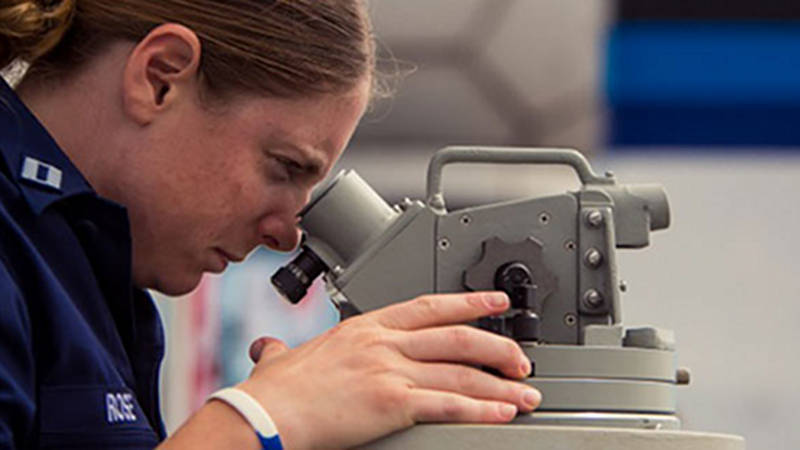
By Emily Rose - Operations Officer on NOAA Ship Okeanos Explorer
October 2, 2014

Emily uses the ship's alidade to take visual bearings while navigating terrestrially, or when the ship is close enough to land to use terrestrial landmarks. Image courtesy of the NOAA Office of Ocean Exploration and Research, Exploring Atlantic Canyons and Seamounts 2014. Download image (jpg, 38 KB).
As the Operations Officer aboard NOAA Ship Okeanos Explorer, my job is to coordinate all of the scientific mission objectives with the ship and the ship’s command.
It is important for me to ensure the ship is capable of safely and effectively accomplishing the objectives the science team sets forth in the project instructions. When the ship is unable to accomplish a mission objective, perhaps due to weather conditions or an equipment malfunction, it is my job to let the scientific team and ship’s crew know we are moving to Plan B. On Okeanos Explorer, Plan B usually involves collecting mapping data as opposed to launching the remotely operated vehicle.
As the Operations Officer, my day usually begins at 0645, when I get out of bed and get ready for the day. I then proceed down to breakfast for a quick meal, which I usually bring with me on the road to the bridge.
Once on the bridge, I make myself familiar with all of the equipment settings, check the radios for functionality, plot our position on the nautical chart, and discuss with the Officer of the Deck (OOD) what operations are taking place. When I have proven my understanding of the situation on the bridge, I will relieve the OOD and assume responsibility of the ship. I will stand watch for approximately four hours, taking fixes and logging the current weather conditions hourly and constantly monitoring the ship’s systems (steering, engines, radars) to ensure everything is properly functioning. When my relief arrives on the bridge, he or she will become familiar with the situation, much like I did, and prepare to take the watch.
Once I am off watch, I usually visit the gym and do a workout and run or bike for a little while. After working out, I get started on sifting through emails and ensuring the ship and the scientific team are on the same page with operations. I then prepare myself for our daily Operations Meeting, a meeting in which the lead scientists; ship’s command, including the Commanding Officer, Executive Officer, Navigation Officer, and of course, me, the Operations Officer; Chief Engineer; Chief Boatswain; and Chief Electronics Technician gather to discuss the day’s operations and discuss upcoming operations.
Once we have discussed plans for the next day's operations, I return to my stateroom and compile the activities on the Plan of the Day (POD). When the POD has been approved by the Executive Officer, I post it throughout the ship. After the POD has been posted, it is time for dinner, a phone call home, and a quick rest before returning to the bridge for my second watch shift.
After standing another four hour watch, I return to my stateroom and try to sleep as quickly as possible, because in a few short hours, I will be awake again, ready for another exciting day at sea.